Related Research Articles

The Coptic Orthodox Church of Alexandria is an Oriental Orthodox Christian church based in Egypt, Africa and the Middle East. The head of the church and the See of Alexandria is the Patriarch of Alexandria on the Holy See of Saint Mark, who also carries the title of Coptic Pope. The See of Alexandria is titular, and today the Coptic Pope presides from Saint Mark's Coptic Orthodox Cathedral in the Abbassia District in Cairo. The church follows the Alexandrian Rite for its liturgy, prayer and devotional patrimony. With approximately 10 million members worldwide, it is the country's largest Christian denomination.
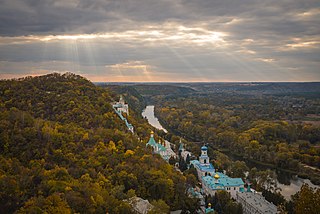
A lavra or laura is a type of monastery consisting of a cluster of cells or caves for hermits, with a church and sometimes a refectory at the center. It is erected within the Orthodox and other Eastern Christian traditions. The term is also used by some Roman Catholic communities. The term in Greek initially meant a narrow lane or an alley in a city.
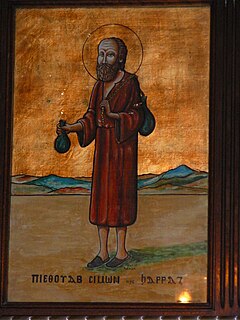
Simon the Tanner, also known as Saint Simon the Shoemaker is the Coptic Orthodox saint associated with the story of the moving the Mokattam Mountain in Cairo, Egypt, during the rule of the Muslim Fatimid Caliph al-Muizz Lideenillah (953–975) while Abraham the Syrian was the Pope of the Coptic Orthodox Church of Alexandria.
Cyril III, known as Cyril ibn Laqlaq, was the 75th Coptic Pope and Patriarch of Alexandria.

The Pope of the Coptic Orthodox Church of Alexandria is the leader of the Coptic Orthodox Church of Alexandria, a faith with ancient Christian roots in Egypt. The current holder of this position is Pope Tawadros II, who was selected as the 118th pope on November 18, 2012.

Saint John the Dwarf, also called Saint John Colobus,Saint John Kolobos or Abba John the Dwarf, was an Egyptian Desert Father of the early Christian church.

The Monastery of Saint Macarius The Great also known as Dayr Aba Maqār is a Coptic Orthodox monastery located in Wadi El Natrun, Beheira Governorate, about 92 km (57 mi) north-west of Cairo, and off the highway between Cairo and Alexandria.
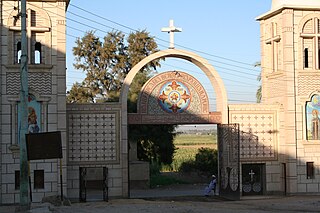
The Coptic White Monastery is a Coptic Orthodox monastery named after Saint Shenouda the Archimandrite. It is located near the Upper Egyptian cities of Tahta and Sohag, and about two and a half miles (4.0 km) south-east of the Red Monastery. The name of the monastery is derived from the colour of the white limestone of its outside walls. The White Monastery is architecturally similar to the Red Monastery.

The Monastery of Saint Mary El-Sourian is a Coptic Orthodox monastery located in Wadi El Natrun in the Nitrian Desert, Beheira Governorate, Egypt. It is located about 500 meters northwest of the Monastery of Saint Pishoy.

The Monastery of Saint Anthony is a Coptic Orthodox monastery standing in an oasis in the Eastern Desert of Egypt, in the southern part of the Suez Governorate. Hidden deep in the Red Sea Mountains, it is located 334 km (208 mi) southeast of Cairo. The Monastery of Saint Anthony was established by the followers of Saint Anthony, who is the first Christian monk. The Monastery of St. Anthony is one of the most prominent monasteries in Egypt and has strongly influenced the formation of several Coptic institutions, and has promoted monasticism in general. Several patriarchs have come from the monastery, and several hundred pilgrims visit it each day.

Coptic Cairo is a part of Old Cairo which encompasses the Babylon Fortress, the Coptic Museum, the Hanging Church, the Greek Church of St. George and many other Coptic churches and historical sites. It is believed in Christian tradition that the Holy Family visited this area and stayed at the site of Saints Sergius and Bacchus Church. Coptic Cairo was a stronghold for Christianity in Egypt both before and during the Islamic era, as most of its churches were built after the Muslim conquest of Egypt in the 7th century.
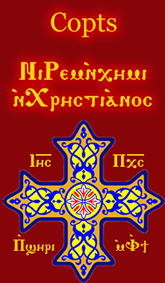
Coptic Monasticism is said to be the original form of Monasticism as St. Anthony of Egypt became the first one to be called "monk" and he was the first to establish a Christian monastery which is now known as the Monastery of Saint Anthony in the Red Sea area. St. Anthony's Monastery is the oldest Christian monastery in the world.

The Monastery of Saint Fana is a Coptic Orthodox monastery. It is named after Saint Fana, also known as Bane, Coptic Christian hermit. The monastery is sometimes called the Monastery of Abu Fanah and is also known as the Monastery of the Cross, due to the presence of many beautifully decorated crosses inside its church.
Saint Fana, also known as Abu Fana, Abu Fanah, or Apa Bane was a Coptic hermit. The Monastery of Saint Fana in the diocese of Mallawi, Upper Egypt, is named after him.
Abu l-Makārim Saʿdullāh ibn Jirjis ibn Masʿūd (d.1208) was a priest of the Coptic Orthodox Church of Alexandria in the thirteenth century. Abu al-Makarim is best known as the author of a famous work entitled History of Churches and Monasteries. This was written around 1200.
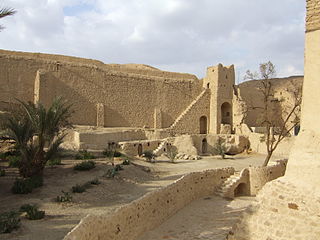
The Monastery of Saint Paul the Anchorite in Egypt is a Coptic Orthodox monastery located in the Eastern Desert, near the Red Sea Mountains. It is about 155 km (96 mi) south east of Cairo. The monastery is also known as the Monastery of the Tigers.

The Monastery of Saint Ammonius, also known as the Monastery of the Martyrs, is a Coptic Orthodox monastery near Esna.

The Monastery of Saint Matthew the Potter, also known as the Monastery of Saint Matthew the Poor, is a Coptic Orthodox monastery in Upper Egypt. It was founded by a Coptic monk of the same name. It is located in Luxor Governorate near the town of Naq 'al-Zinaiqa, about seven kilometers northwest of the village of Asfun al-Matana near Esna. The monastery is built at the edge of the desert. It was uninhabited for a period of time, but in 1975, Coptic Orthodox monks reestablished a presence there. Excavations done by French archeologists between the Monastery of Saint Matthew the Poor and the Monastery of the Martyrs have revealed much about the history of Coptic monasticism in this region.

Monastery of Saint Samuel the Confessor, Dair al-Anba Ṣamū'īl al-mu'tarif " or Deir el-Qalamun is an Egyptian monastery in the western desert.
References
- 2000 Years of Coptic Christianity. By Meinardus, Otto F. A. 1999. American University in Cairo Press. ISBN 977-424-511-3.
- Christian Egypt: Coptic Art and Monuments Through Two Millennia. By Capuani, Massimo. 1999. Liturgical Press. ISBN 0-8146-2406-5.
- Churches and Monasteries of Egypt and Some Neighboring Countries. By Abu al-Makarim [Abu Salih the Armenian]. Edited and Translated by Evetts, B.T.A. 2001. Gorgias Press. ISBN 0-9715986-7-3.